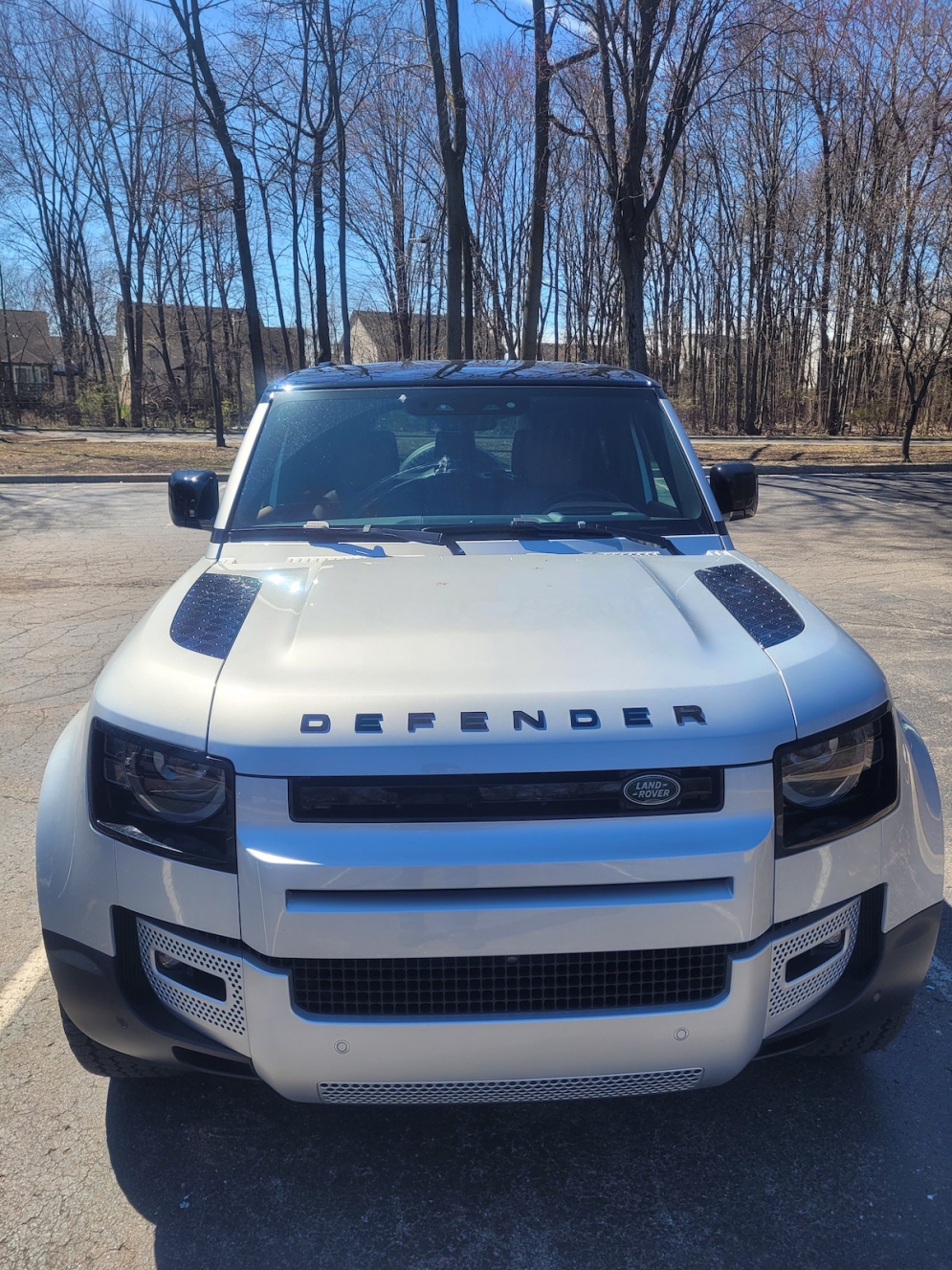LOOKS
The best way to describe the looks of the Land Rover Defender is tank-like. It features a high ground clearance, boxy design, sharp styling, large headlights, and a side-opening rear door.
Its length will vary, depending whether you choose the Defender 90, Defender 110 or Defender 130 model (length ranges from 180 inches to 211 inches). This range of options allows it to fill a variety of customer needs.
The 110 model I drove featured an attractive Hakuba Silver paint color, 20-inch wheels (19-inchers are standard on base model), premium LED headlights, a panoramic roof, rain-sensing front wipers and rear privacy glass.
The rear door opens from the side, as opposed to the usual up/down motion, an interesting feature that differentiates the Defender from most vehicles, but I quickly got used to it.
Seating capacity ranges from 5 passengers to 8 passengers, depending on the model you choose. There’s even an option for a front jump seat in the Defender 90 (though that’s a pretty tight space and I wouldn’t want to sit there).
A third row is offered on the Defender 110, but it’s so tight that if you want three rows it's best to bump up to the roomier Defender 130.
In its five-passenger/two-row setup, the Defender 110 offers 34 cubic feet of cargo space behind the second row, and 78.8 cubic feet behind the first.
Other cargo numbers include Defender 90’s smaller 15.6 cubic feet with both rows up, and 58.3 cubic feet with rear row down.
The Defender 130 features 15.3 cubic feet behind the third row, 35.8 behind the second, and 76.1 behind the first.
These are respectable cargo numbers for the segment.
As far as materials used, the Defender keeps it classy. My test vehicle featured high-quality, luxury-level seating, plus wood accents in the center console and on the door handles. The front of the vehicle featured a sharp design, including a large storage shelf in front of the passenger. The vehicle’s small shifter opens up space in the center of the vehicle, where there is a large shelf down below.
The Defender features leather seating and a leather steering wheel, heated and cooled front seating with memory functions, and two-zone climate control.
The front two rows in the Defender I tested were roomy and comfortable for people of all sizes, and despite its rugged nature the Defender maintains a high-brow feel inside the vehicle.
Those in colder climates will want to choose the Cold Climate Pack, which adds a heated windshield, heated washer jets and heated steering wheel.
HOW’S THE RIDE?
Multiple engine options are available on the Land Rover Defender.
My test vehicle featured a 3.0-liter, 6-cylinder engine, paired with an 8-speed automatic transmission, and delivered an impressive 395 horsepower and 406 pound-feet of torque.
The vehicle also featured all-wheel drive, electric power assisted steering, a variety of driving and off-road modes, and a Hill Descent Control system. All-wheel drive comes standard on all Defender models.
Other engine options offered on various versions of the Defender include
— A 2.0-liter, turbo four-cylinder engine offering 296 horsepower and 295 pound-feet
— A 3.0-liter, turbo six-cylinder mild hybrid offering 296 horsepower and 347 pound-feet
— A 5.0-liter supercharged V8 with 493 horsepower and 450 pound-feet
— A 5.0-liter V8 featuring 518 horsepower and 461 pound-feet
Choosing the Off-Road pack will add an electronic active differential to maximize traction, as well as off-road tires.
Towing capability is also impressive on the Land Rover Defender, coming in at more than 8,000 pounds. That translates to the ability to pull pretty much whatever you need for a getaway — from trailers to campers to boats and off-road vehicles.
Also, the Defender’s electronic air suspension will improve comfort and allow drivers to choose their preferred ground clearance height, including the ability to boost the normal ride height. Ground clearance tops out at 11.5 inches. This is an impressive number and opens up a lot of opportunities to safely take the vehicle on less-traveled byways.
What’s most impressive about the ride is that while it may be built for off-road adventures, the Defender also performs remarkably smoothly in city driving. Many off-roaders are clearly good for that purpose only, but this upscale vehicle is a jack of all trades that performs well on all surfaces.
The Defender gets moving fast and is agile for its size and not overly loud. The most powerful engines offered can go 0-to-60 in less than 5 seconds, while my test vehicle took just over 6 seconds.
Tons of drive modes are offered — allowing for customized settings if you on-road, off-road, towing, climbing hills, fording water, etc. These drive modes include: Eco, Comfort, Grass, Gravel, Snow, Mud ruts, Sand, Rock Crawl, and Wade.
If you feel like testing the Defender’s water capabilities, it’s built to ford through 35 inches of water.
TECHNOLOGY, SAFETY
The Land Rover Defender features a smaller touchscreen than other luxury rides, but it’s still large enough at just over 10 inches.
The controls on the touchscreen, running Land Rover’s Pivi Pro interface, are easy to master, and voice commands worked well for the most part, with only occasional hiccups and repetition needed. The navigation system also was impressive and accurately guided me to my destinations.
The climate controls below the touchscreen are a bit tricky to understand at first and could be simplified. Multiple controls work through the same dials (i.e. heated seats, off-road settings, and climate temperature). You get used to operating these controls, but it's a bit different and takes some time to adjust.
There are several charging ports up front, as well as a wireless phone charger. The vehicle is compatible with Apple CarPlay and Android Auto for phone mirroring, and features Bluetooth connectivity for streaming music and phone calls to the vehicle. Stereo systems offered on the Defender include a six-speaker system, and upgrades to either 10 or 14 speakers.
Safety is an especially strong area for the Land Rover Defender.
I was a big fan of its surround-view camera setup, offering a top-down view which is helpful in situations both on and off the main roads. Other helpful safety features include adaptive cruise control, forward collision mitigation (which stops the car when a collision is imminent), lane keeping system and blind-spot warning.
There’s also a trailer sway damping system, which helps control trailer movement if it begins to sway.
If you’re going to be trudging through watery areas, a water depth sensor will keep track to let you know if you’re getting too deep. And inside the vehicle, there is a driver attention warning which will sound if it appears the driver is becoming too fatigued.
There’s also your usual array of airbags, emergency collision notification, stolen vehicle locator, tire pressure monitoring system, electronic traction control, dynamic stability control, anti-lock brakes and a helpful Head-up Display.
MPG
While the official numbers on the Defender I tested were 18 city/23 highway/20 combined, I experienced a lower number — averaging just 16 mpg.
However, it’s worth noting that even with the lower results, the Defender is more efficient that the Mercedes-Benz G-Wagon, though it trails other competitors.
Your mileage will vary depending on the model you choose (90, 110, 130) and what is under the hood.|
PRICE
To say there is a wide variety of pricing on the Land Rover Defender would be an understatement. The base price starts around $57K, and the most high-end offering comes in at more than $120K. My test vehicle came in just under $90K.
This is a bargain compared to the Mercedes Benz G-Class, a luxury off-road capable machine which starts north of $140K. It’s more expensive than off-road friendly vehicles including the Toyota Land Cruiser, Jeep Wrangler and Ford Bronco, but also much more refined and upscale than those options.
Warranties are just average on the Defender, including:
— Overall warranty covers four years or 50,000 miles
— Powertrain coverage for four years of 50,000 miles
There is no complimentary scheduled maintenance, a feature offered on many new vehicles.
BOTTOM LINE
The Land Rover Defender features a head-turning, rugged and boxy design, upscale interior; plus tremendous off-road prowess and adjustability for various driving circumstances.
It’s a strong vehicle option for anyone seeking a high-end off-road vehicle that’ll fit in equally both storming through the wilderness and on a trip to the country club.
===
AutoTechReviews.com can be found on Twitter @AutoTechReview, or stay updated at the AutoTechReviews Facebook page. Follow AutoTechReviews on Instagram at @Autotechreviews. Matt Myftiu can be found on Twitter @MattMyftiu




